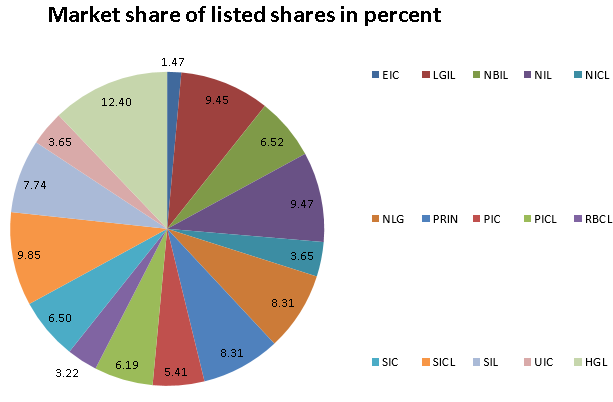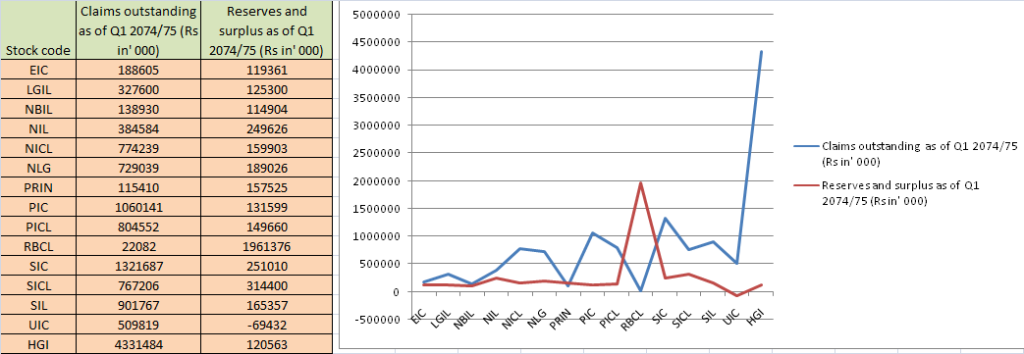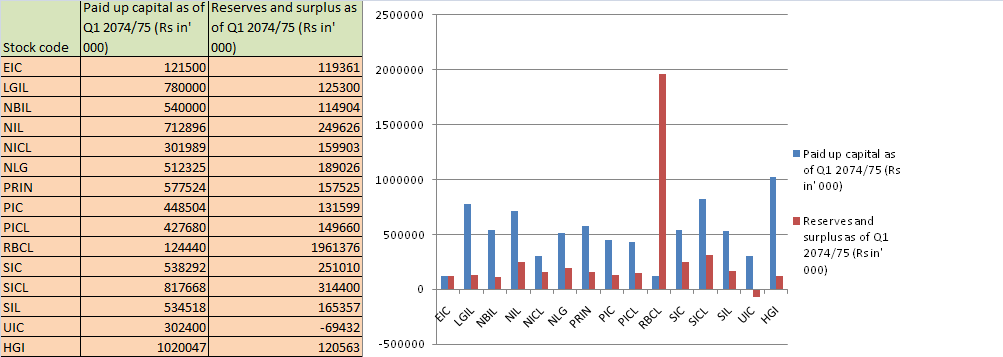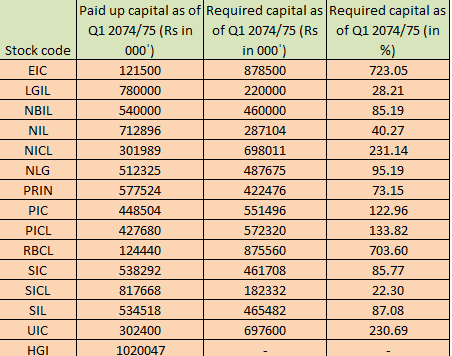Series II -Know more about non life insurance company and design your investment portfolio accordingly!
Wed, Nov 29, 2017 2:18 PM on Latest, Exclusive, Featured, Stock Market,

Having learnt about the background of the non life insurance companies, it is now necessary to understand the financial status of these companies. The following paragraphs underline several indices and its interpretation.
Which non life company lists what amount of shares in NEPSE?
Investor needs to know which company has what number of shares listed in the NEPSE. This provides an insight to the investors about the demand and supply of the company’s share. For instance, total number of shares listed of non-life insurance companies is 82,849,290 in NEPSE as of November 24, 2017. Among these listed shares, Himalayan General Insurance Company Limited (HGI) holds the highest proportion of the market share in terms of listed shares i.e. 10,272,128 shares 24thNovember, 2017. The same company is the only company which has met the paid up capital requirement as set by the Insurance Board. Hence, it can be implied that since HGI has the highest shares in terms of listed share so, the company has comparatively greater supply of its shares in the stock market. On the other hand, the company with lowest proportion of shares in the stock market i.e. Everest Insurance Company (EIC) implies that there may not be optimum supply of shares of the company in the stock market.The data presented sums up the number of listed shares (percentage) in NEPSE as of 24thNovember,2017.
 What relation does the EPS and market price hold in non life insurance industry?
Earnings per share basically reflect the portion of company’s earning provided to each outstanding shares of common stocks. In laymen terms, it is basically the amount you earn for holding one share of the company. On the other hand, current market price represents the price, at which one can buy the share of the company. The relationship between annualized EPS and current market price is essential to know as it shows what amount you need to give up in order to gain the desired earning in a year from the trade of the shares of a company. For instance, as of 24th November, 2017, the data shows that the Rastriya Beema Company Limited has the highest EPS i.e. 154.34 and the same company has highest market price i.e. 16000. So, in order to gain higher earning, one needs to invest higher amount. Similarly, Himalayan General Insurance Company Limited has the lowest market price i.e. Rs 620 as well as the lowest EPS i.e. Rs 8.75. Therefore, if the investor is available with less fund, and invests in HGIC, then the earning that the investor gains is also comparatively low.
What relation does the EPS and market price hold in non life insurance industry?
Earnings per share basically reflect the portion of company’s earning provided to each outstanding shares of common stocks. In laymen terms, it is basically the amount you earn for holding one share of the company. On the other hand, current market price represents the price, at which one can buy the share of the company. The relationship between annualized EPS and current market price is essential to know as it shows what amount you need to give up in order to gain the desired earning in a year from the trade of the shares of a company. For instance, as of 24th November, 2017, the data shows that the Rastriya Beema Company Limited has the highest EPS i.e. 154.34 and the same company has highest market price i.e. 16000. So, in order to gain higher earning, one needs to invest higher amount. Similarly, Himalayan General Insurance Company Limited has the lowest market price i.e. Rs 620 as well as the lowest EPS i.e. Rs 8.75. Therefore, if the investor is available with less fund, and invests in HGIC, then the earning that the investor gains is also comparatively low.
 Claim outstanding and reserves of the companies:
The major obligation of a non insurance company lies in the compensation of claims. The claims outstanding show how much claim is yet to be settled by the company. But insurance companies are not liable to settle all the outstanding claims from the reserve as most part of the claims are settled from re-insurance company.
The figure provided shows, the only company that has met the paid up capital requirement, Himalayan General Insurance has the highest claims outstanding. Similarly, RBCL has the lowest claims outstanding with highest reserves in hand. UIC has its reserves in negative.
Claim outstanding and reserves of the companies:
The major obligation of a non insurance company lies in the compensation of claims. The claims outstanding show how much claim is yet to be settled by the company. But insurance companies are not liable to settle all the outstanding claims from the reserve as most part of the claims are settled from re-insurance company.
The figure provided shows, the only company that has met the paid up capital requirement, Himalayan General Insurance has the highest claims outstanding. Similarly, RBCL has the lowest claims outstanding with highest reserves in hand. UIC has its reserves in negative.
 Paid up capital and reserve! Which company holds the most?
Paid up capital is the amount of capital collected by the company through general public in exchange of the shares of the company. In simple terms, if you have bought the shares of a company worth Rs 25000, then the paid up capital is the accumulation of your investment of Rs 25000 along with the investment of other investors, like you, who have bought the shares of the company. Reserve refers to the part of shareholder’s equity that has been accumulated from the net profit it had earned in the previous fiscal year which may be use to settle the liabilities if any arises in the future. The table shows that Himalayan General Insurance Company has the highest amount of paid up capital followed by Shikhar Insurance Company Limited. In contrast, Everest Insurance Company has the lowest paid up capital. Similarly, Rastriya Beema Company Limited has the highest amount of reserve while United Insurance Company (Nepal) Limited has a negative reserve fund.
Paid up capital and reserve! Which company holds the most?
Paid up capital is the amount of capital collected by the company through general public in exchange of the shares of the company. In simple terms, if you have bought the shares of a company worth Rs 25000, then the paid up capital is the accumulation of your investment of Rs 25000 along with the investment of other investors, like you, who have bought the shares of the company. Reserve refers to the part of shareholder’s equity that has been accumulated from the net profit it had earned in the previous fiscal year which may be use to settle the liabilities if any arises in the future. The table shows that Himalayan General Insurance Company has the highest amount of paid up capital followed by Shikhar Insurance Company Limited. In contrast, Everest Insurance Company has the lowest paid up capital. Similarly, Rastriya Beema Company Limited has the highest amount of reserve while United Insurance Company (Nepal) Limited has a negative reserve fund.
 Have all the non life insurance companies met the required paid up capital?
With the Insurance Board’s direction to all the non life insurance companies to increase their paid up capital to NRs 1 arba, the non life insurance companies are obliged to issue shares (especially right share) to the general public. For instance, only one non life insurance company i.e. Himalayan General Insurance Company has met the required paid up capital so; there are high chances that general public will be exposed with opportunity to take benefit from the issue of shares in this industry. Everest Insurance Company has the highest requirement of paid up capital so, it can be generalized that the company will certainly issue more right shares to the public in case of no other alternatives chosen by the company.
Have all the non life insurance companies met the required paid up capital?
With the Insurance Board’s direction to all the non life insurance companies to increase their paid up capital to NRs 1 arba, the non life insurance companies are obliged to issue shares (especially right share) to the general public. For instance, only one non life insurance company i.e. Himalayan General Insurance Company has met the required paid up capital so; there are high chances that general public will be exposed with opportunity to take benefit from the issue of shares in this industry. Everest Insurance Company has the highest requirement of paid up capital so, it can be generalized that the company will certainly issue more right shares to the public in case of no other alternatives chosen by the company.
 Disclaimer: Any kind of information that is provided in the above presentation should not be used as a sole advice or recommendation by investors in order to design their investment portfolio. So, before taking steps for any kind of the information, the investors are required to base their judgement on their own financial analysis, appropriateness of the information and seek independent financial advice.
Disclaimer: Any kind of information that is provided in the above presentation should not be used as a sole advice or recommendation by investors in order to design their investment portfolio. So, before taking steps for any kind of the information, the investors are required to base their judgement on their own financial analysis, appropriateness of the information and seek independent financial advice.
 What relation does the EPS and market price hold in non life insurance industry?
Earnings per share basically reflect the portion of company’s earning provided to each outstanding shares of common stocks. In laymen terms, it is basically the amount you earn for holding one share of the company. On the other hand, current market price represents the price, at which one can buy the share of the company. The relationship between annualized EPS and current market price is essential to know as it shows what amount you need to give up in order to gain the desired earning in a year from the trade of the shares of a company. For instance, as of 24th November, 2017, the data shows that the Rastriya Beema Company Limited has the highest EPS i.e. 154.34 and the same company has highest market price i.e. 16000. So, in order to gain higher earning, one needs to invest higher amount. Similarly, Himalayan General Insurance Company Limited has the lowest market price i.e. Rs 620 as well as the lowest EPS i.e. Rs 8.75. Therefore, if the investor is available with less fund, and invests in HGIC, then the earning that the investor gains is also comparatively low.
What relation does the EPS and market price hold in non life insurance industry?
Earnings per share basically reflect the portion of company’s earning provided to each outstanding shares of common stocks. In laymen terms, it is basically the amount you earn for holding one share of the company. On the other hand, current market price represents the price, at which one can buy the share of the company. The relationship between annualized EPS and current market price is essential to know as it shows what amount you need to give up in order to gain the desired earning in a year from the trade of the shares of a company. For instance, as of 24th November, 2017, the data shows that the Rastriya Beema Company Limited has the highest EPS i.e. 154.34 and the same company has highest market price i.e. 16000. So, in order to gain higher earning, one needs to invest higher amount. Similarly, Himalayan General Insurance Company Limited has the lowest market price i.e. Rs 620 as well as the lowest EPS i.e. Rs 8.75. Therefore, if the investor is available with less fund, and invests in HGIC, then the earning that the investor gains is also comparatively low.
 Claim outstanding and reserves of the companies:
The major obligation of a non insurance company lies in the compensation of claims. The claims outstanding show how much claim is yet to be settled by the company. But insurance companies are not liable to settle all the outstanding claims from the reserve as most part of the claims are settled from re-insurance company.
The figure provided shows, the only company that has met the paid up capital requirement, Himalayan General Insurance has the highest claims outstanding. Similarly, RBCL has the lowest claims outstanding with highest reserves in hand. UIC has its reserves in negative.
Claim outstanding and reserves of the companies:
The major obligation of a non insurance company lies in the compensation of claims. The claims outstanding show how much claim is yet to be settled by the company. But insurance companies are not liable to settle all the outstanding claims from the reserve as most part of the claims are settled from re-insurance company.
The figure provided shows, the only company that has met the paid up capital requirement, Himalayan General Insurance has the highest claims outstanding. Similarly, RBCL has the lowest claims outstanding with highest reserves in hand. UIC has its reserves in negative.
 Paid up capital and reserve! Which company holds the most?
Paid up capital is the amount of capital collected by the company through general public in exchange of the shares of the company. In simple terms, if you have bought the shares of a company worth Rs 25000, then the paid up capital is the accumulation of your investment of Rs 25000 along with the investment of other investors, like you, who have bought the shares of the company. Reserve refers to the part of shareholder’s equity that has been accumulated from the net profit it had earned in the previous fiscal year which may be use to settle the liabilities if any arises in the future. The table shows that Himalayan General Insurance Company has the highest amount of paid up capital followed by Shikhar Insurance Company Limited. In contrast, Everest Insurance Company has the lowest paid up capital. Similarly, Rastriya Beema Company Limited has the highest amount of reserve while United Insurance Company (Nepal) Limited has a negative reserve fund.
Paid up capital and reserve! Which company holds the most?
Paid up capital is the amount of capital collected by the company through general public in exchange of the shares of the company. In simple terms, if you have bought the shares of a company worth Rs 25000, then the paid up capital is the accumulation of your investment of Rs 25000 along with the investment of other investors, like you, who have bought the shares of the company. Reserve refers to the part of shareholder’s equity that has been accumulated from the net profit it had earned in the previous fiscal year which may be use to settle the liabilities if any arises in the future. The table shows that Himalayan General Insurance Company has the highest amount of paid up capital followed by Shikhar Insurance Company Limited. In contrast, Everest Insurance Company has the lowest paid up capital. Similarly, Rastriya Beema Company Limited has the highest amount of reserve while United Insurance Company (Nepal) Limited has a negative reserve fund.
 Have all the non life insurance companies met the required paid up capital?
With the Insurance Board’s direction to all the non life insurance companies to increase their paid up capital to NRs 1 arba, the non life insurance companies are obliged to issue shares (especially right share) to the general public. For instance, only one non life insurance company i.e. Himalayan General Insurance Company has met the required paid up capital so; there are high chances that general public will be exposed with opportunity to take benefit from the issue of shares in this industry. Everest Insurance Company has the highest requirement of paid up capital so, it can be generalized that the company will certainly issue more right shares to the public in case of no other alternatives chosen by the company.
Have all the non life insurance companies met the required paid up capital?
With the Insurance Board’s direction to all the non life insurance companies to increase their paid up capital to NRs 1 arba, the non life insurance companies are obliged to issue shares (especially right share) to the general public. For instance, only one non life insurance company i.e. Himalayan General Insurance Company has met the required paid up capital so; there are high chances that general public will be exposed with opportunity to take benefit from the issue of shares in this industry. Everest Insurance Company has the highest requirement of paid up capital so, it can be generalized that the company will certainly issue more right shares to the public in case of no other alternatives chosen by the company.
 Disclaimer: Any kind of information that is provided in the above presentation should not be used as a sole advice or recommendation by investors in order to design their investment portfolio. So, before taking steps for any kind of the information, the investors are required to base their judgement on their own financial analysis, appropriateness of the information and seek independent financial advice.
Disclaimer: Any kind of information that is provided in the above presentation should not be used as a sole advice or recommendation by investors in order to design their investment portfolio. So, before taking steps for any kind of the information, the investors are required to base their judgement on their own financial analysis, appropriateness of the information and seek independent financial advice.


